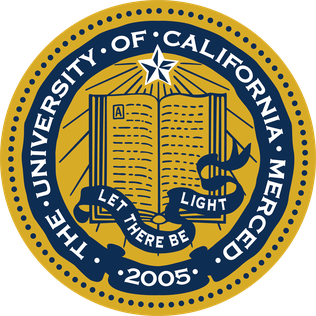Related Research Articles

The University of California, Merced is a public land-grant research university in Merced, California. It is one of the ten campuses in the University of California (UC) system. Established in 2005, UC Merced is the newest campus within the UC system. The primary campus is located around five miles north of Merced and sits adjacent to Lake Yosemite. The main campus is around 1,026 acres in size. Large swaths of protected natural grasslands surround the university.

Green building refers to both a structure and the application of processes that are environmentally responsible and resource-efficient throughout a building's life-cycle: from planning to design, construction, operation, maintenance, renovation, and demolition. This requires close cooperation of the contractor, the architects, the engineers, and the client at all project stages. The Green Building practice expands and complements the classical building design concerns of economy, utility, durability, and comfort. Green building also refers to saving resources to the maximum extent, including energy saving, land saving, water saving, material saving, etc., during the whole life cycle of the building, protecting the environment and reducing pollution, providing people with healthy, comfortable and efficient use of space, and being in harmony with nature. Buildings that live in harmony; green building technology focuses on low consumption, high efficiency, economy, environmental protection, integration and optimization.’
Green development is a real estate development concept that considers social and environmental impacts of development. It is defined by three sub-categories: environmental responsiveness, resource efficiency, and community and cultural sensitivity. Environmental responsiveness respects the intrinsic value of nature, and minimizes damage to an ecosystem. Resource efficiency refers to the use of fewer resources to conserve energy and the environment. Community and cultural sensitivity recognizes the unique cultural values that each community hosts and considers them in real estate development, unlike more discernable signs of sustainability, like solar energy,. Green development manifests itself in various forms, however it is generally based on solution multipliers: features of a project that provide additional benefits, which ultimately reduce the projects' environmental impacts.

Leadership in Energy and Environmental Design (LEED) is a green building certification program used worldwide. Developed by the non-profit U.S. Green Building Council (USGBC), it includes a set of rating systems for the design, construction, operation, and maintenance of green buildings, homes, and neighborhoods, which aims to help building owners and operators be environmentally responsible and use resources efficiently.

A Zero-Energy Building (ZEB), also known as a Net Zero-Energy (NZE) building, is a building with net zero energy consumption, meaning the total amount of energy used by the building on an annual basis is equal to the amount of renewable energy created on the site or in other definitions by renewable energy sources offsite, using technology such as heat pumps, high efficiency windows and insulation, and solar panels.

Energy engineering is a broad field of engineering dealing with areas such as energy harvesting and storage, energy conversion, energy materials, energy systems, energy efficiency, energy services, facility management, plant engineering, energy modelling, environmental compliance, sustainable energy and renewable energy technologies. Energy engineering is one of the most recent engineering disciplines to emerge. Energy engineering combines knowledge from the fields of physics, math, and chemistry with economic and environmental engineering practices. Energy engineers apply their skills to increase efficiency and further develop renewable sources of energy. The main job of energy engineers is to find the most efficient and sustainable ways to operate buildings and manufacturing processes. Energy engineers audit the use of energy in those processes and suggest ways to improve the systems. This means suggesting advanced lighting, better insulation, more efficient heating and cooling properties of buildings. Although an energy engineer is concerned about obtaining and using energy in the most environmentally friendly ways, their field is not limited to strictly renewable energy like hydro, solar, biomass, or geothermal. Energy engineers are also employed by the fields of oil and natural gas extraction.

Robert "Rob" Watson is an international leader and expert in business and market transformation, circular economy, and green buildings. Working globally to solve large infrastructure and systems problems at scale, he founded the LEED Green Building Rating System of the United States Green Building Council (USGBC) in 1993 and was the LEED Steering Committee’s founding chairman and led its activity until 2006. In 2015, he founded the SWEEP Standard for sustainable materials management.

Efficient energy use, or energy efficiency, is the process of reducing the amount of energy required to provide products and services. There are many technologies and methods available that are more energy efficient than conventional systems. For example, insulating a building allows it to use less heating and cooling energy while still maintaining a comfortable temperature. Another method is to remove energy subsidies that promote high energy consumption and inefficient energy use. Improved energy efficiency in buildings, industrial processes and transportation could reduce the world's energy needs in 2050 by one third.
Perkins&Will is a global design practice founded in 1935. Since 1986, the group has been a subsidiary of Lebanon-based Dar Al-Handasah.
This article provides examples of green building programs in the United States. These programs span the public, private, and non-profit sectors, and all have the goal of increasing energy efficiency and the sustainability of the built environment.

IGS Energy, also known as Interstate Gas Supply, Inc., is an independent retail natural gas and electric supplier based in Dublin, Ohio, United States. It serves more than 1,000,000 residential, commercial and industrial customers in the states of Ohio, Michigan, Kentucky, New York, Pennsylvania, Indiana, Virginia, Maryland, Texas, California and Illinois. The company was founded in 1989, and today employs more than 900 people across 18 states.
Green building on college campuses is the purposeful construction of buildings on college campuses that decreases resource usage in both the building process and also the future use of the building. The goal is to reduce CO2 emissions, energy use, and water use, while creating an atmosphere where students can be healthy and learn.

The Bren School of Environmental Science & Management is the graduate environmental studies school of the University of California, Santa Barbara.

David Michael Harper is an American architect, business leader and sustainable energy advocate. He is the Chief Design Officer, Practice Leader and Director for SNC-Lavalin Atkins. Engineering News Record (ENR) has ranked SNC-Lavalin Group as the 19th largest Design and CM-PM firm in the United States with 2022 Revenue of $1.5 Billion. Previously before assuming his current role he was the Global Higher Education Practice Leader and the Managing Director for HKS, Inc.

"Sustainability," was defined as “development which implies meeting the needs of the present without compromising the ability of future generations to meet their own needs”as defined by the 1983 Brundtland Commission. As sustainability gains support and momentum worldwide, universities across the United States have expanded initiatives towards more sustainable campuses, commitments, academic offerings, and student engagement.

Gregory H. Kats is an American businessman, environmentalist, and thought leader in the green economy sector. He is founder and CEO of the Smart Surfaces Coalition, a non-profit organization consisting of 40+ national and international partner groups working to ensure the rapid, cost-effective adoption of reflective, porous, and green urban surface infrastructure, or "smart surfaces", in cities. Previously, Kats served as a Managing Director at Good Energies,[2] a multi-billion dollar global clean energy investor, and Director of Financing for Energy Efficiency and Renewable Energy at the U.S. Department of Energy (DOE).[3]
NASA Sustainability Base is located on the campus of NASA's Ames Research Center in Moffett Field, California. It was named in recognition of the first human outpost on the moon, Tranquility Base. It was designed to exhibit and test the latest energy-saving technologies as part of the federal government's drive to eliminate fossil-fuel consumption in all new government buildings by 2030. The building was not initially conceived as a "sustainability base", but associate director Steven Zornestzer worked with architect William McDonough to create an energy-efficient building for the 21st century. McDonough, previously published "Cradle to Cradle", which argued for building architecture to move out of the "life cycle" model and become a more circular system, lasting for indefinite periods of time. This belief, along with other influences from looking at urban design and architecture through a biological perspective, provided inspiration for the NASA Sustainability Base. Energy-saving features include water recycling, fuel cell electricity generation, natural lighting, solar panels, and a geothermal well system. The building takes advantage of the sun's arc and winds from San Francisco Bay in addition to being able to adjust to changes in sunlight, temperature, wind, and occupancy. Also, the building had normal budget and actually a shorter than normal production time. One of the nation's greenest buildings, the NASA Sustainability Base was awarded the U.S. Green Building Council's Leadership in Energy and Environmental Design (LEED) Platinum status. It was completed in December 2012 and cost $27.8 million.

The Wisconsin Energy Institute serves as the collaborative home of energy research and education for the University of Wisconsin-Madison campus and greater Midwestern region, and houses the Great Lakes Bioenergy Research Center, along with research space for the Nelson Institute for Environmental Studies.
Jerry Yudelson is an environmentalist and author, best known for publishing 14 green building and sustainable design books since 2006. Yudelson’s work is focused on the long-term environmental impact that urban development has on climate change, resulting from greenhouse gas emissions caused by operating home and buildings.
The Institute for Energy Efficiency (IEE) is a research institute of the University of California, Santa Barbara (UCSB). IEE is an interdisciplinary research institute dedicated to the development of science and technologies that increase energy efficiency, reduce energy consumption, and support an efficient and sustainable energy future.
References
- ↑ "Sustainable Nation Podcast | Matt St. Clair - Sustainability Leadership at the University of California". Sustridge Sustainability Consulting. April 2018. Retrieved 2021-08-11.
- 1 2 "Staff Snapshot: Matt St. Clair, fighting to keep UC, and the planet, healthy | UCnet". ucnet.universityofcalifornia.edu. 9 November 2020. Retrieved 2021-08-11.
- ↑ "St. Clair, Matt". EEI. 2020-08-19. Retrieved 2021-08-11.
- ↑ "St. Clair, Matthew". Energy & Resources Group. 2014-03-31. Retrieved 2021-08-11.
- 1 2 "Our Board". SEI. Retrieved 2021-08-11.
- 1 2 "Matt St.Clair Shares How He Advances Sustainability at UC". The Association for the Advancement of Sustainability in Higher Education. 2017-11-20. Retrieved 2021-08-11.
- ↑ "California Universities Are Transitioning to All-Electric Buildings". www.greentechmedia.com. Retrieved 2021-08-11.
- ↑ "Matt St. Clair is named a 2020 LEED Fellow" . Retrieved 2021-08-11.
- 1 2 "University of California's Director of Sustainability: Matt St. Clair". GBES. Retrieved 2021-08-11.
- ↑ "UC makes bold commitment to 100 percent clean electricity". University of California. 2018-10-29. Retrieved 2021-08-11.
- ↑ "Green Business Certification Inc. Celebrates the 2020 Class of LEED Fellows | U.S. Green Building Council". www.usgbc.org. Retrieved 2021-08-11.